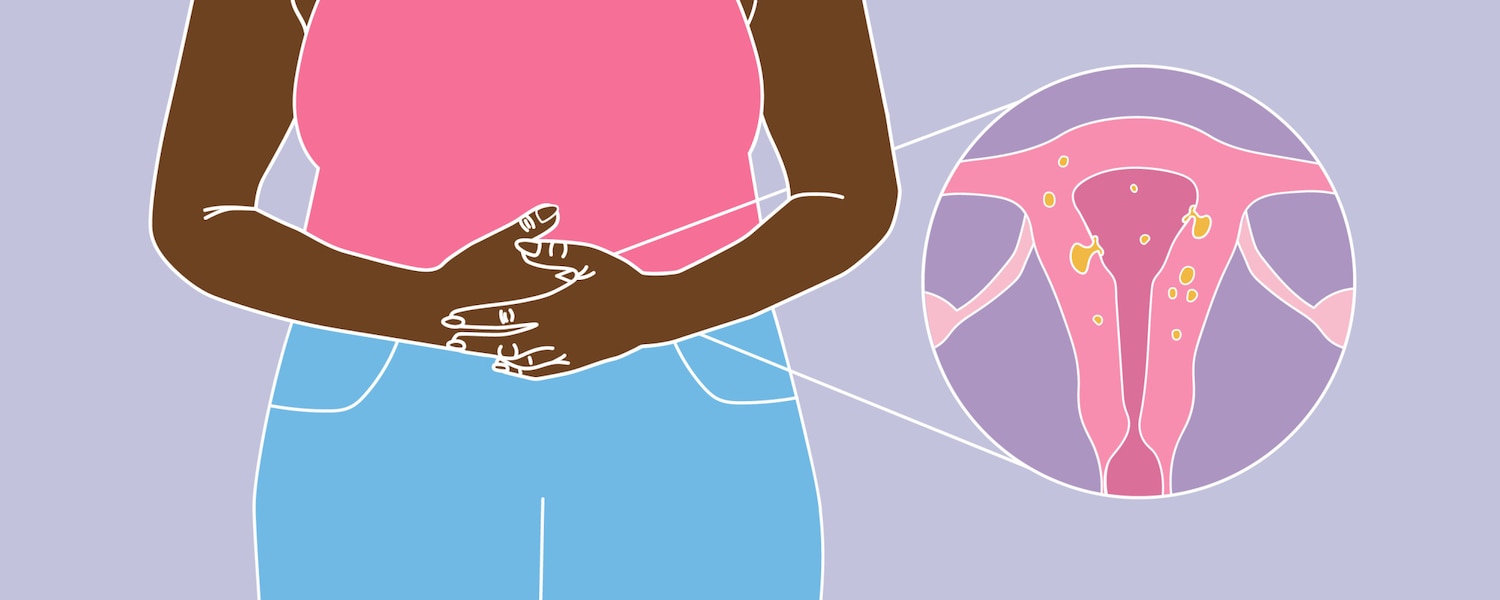What is adenomyosis and how do you know if you have it?

While heavy menstrual bleeding and painful cramps are quite common, they’re not always signs of a normal menstrual cycle. They could be warning us about adenomyosis, endometriosis, or uterine fibroids. But because these conditions share similar symptoms, they are often confused or misdiagnosed. So, what exactly is adenomyosis and how can we tell it apart?
Adenomyosis is a condition where the cells that usually form the uterus lining (also known as the endometrium) grow into the muscle wall of the uterus itself – where they’re not supposed to be. Around 1 in 10 women are affected by adenomyosis, yet a third don’t even realise it.[1]
But, how can that be? Likely, a combination of factors: on one hand, science and medicine haven’t historically paid that much attention to the health issues of women+, leading to underfunding of research to helps us understand conditions like adenomyosis.[2], [3] On the other, the taboos around our V-Zones (the vagina, vulva and V-shaped front of our bodies) feed the belief that they’re actually not something to discuss. For instance, many of us grew up believing that periods weren’t something we should talk about, at least not seriously. Or that we should just learn to deal with them and suffer in silence. Or that even if we did share, others might not understand – it’s just a period, bad cramps are normal and will go away eventually… right? But it doesn’t have to be this way! Just because others can’t physically see the pain, it doesn’t mean it’s not there – your pain is real, and what you feel is valid. This is why talking about adenomyosis matters.
Learning more about this condition can enable you to recognise the symptoms early and seek the proper medical support you need. Or perhaps equip you with the knowledge to support a family member, co-worker, or someone you know who might be dealing with it. So, let’s have a look…
What causes adenomyosis?
The short answer is that we’re not sure yet. Science hasn’t quite figured out what exactly causes adenomyosis. This is due to a severe lack of medical research that often leaves the condition underdiagnosed.
With little known about it, one theory suggests that adenomyosis happens due to injury to the uterus during childbirth (including C-sections). Another theory proposes that it might be caused by a genetic condition.[4]
Having only barely scratched the surface of what causes adenomyosis, we can only hope the answer is just around the corner.
What are the symptoms of adenomyosis?
Symptoms of adenomyosis are extremely varied and no two people will experience it the same way. But they do tend to include heavy menstrual bleeding, bloating (due to the swelling of the uterus), and severe period pain. You may even experience mental and emotional fatigue that makes you want nothing more than to cuddle up in bed.
Although it can be daunting to go through this every cycle, try not to be too hard on your body. If something does not feel right and these symptoms sound familiar, speaking to your doctor might be a good idea. It can also help to reach out to other women+ going through the same journey as you. Sharing your experiences with others – whether it’s a mother figure, sibling, friend or a loved one – and even joining online communities specialising in adenomyosis could be a great way of getting the emotional support you need.
Adenomyosis vs. endometriosis: what’s the difference?
The lining of the uterus grows and thickens during our menstrual cycle and this lining is then shed during our period. When the cells of the uterus lining spread to places they shouldn’t, you can develop conditions such as adenomyosis and endometriosis.
Given that they share symptoms, it’s no surprise the two conditions are easily confused. They can also happen simultaneously, making it difficult to get an accurate diagnosis. And although adenomyosis and endometriosis may seem similar, they affect different parts of the body and thus, may get different treatments.
Inside vs. outside
In the case of adenomyosis, the cells grow deep inside the uterus muscle tissue; they continue working as usual (getting thicker and bigger every cycle) and then bleed when your hormones signal that it’s menstruation time.
For endometriosis, these cells grow outside the uterus and can be found in other places like your ovaries, fallopian tubes, and bladder. The displaced cells carry on as usual here as well – getting thicker and bleeding during your period, which causes the nearby tissue to swell and scar.
What’s the difference between uterine fibroids and adenomyosis?
While adenomyosis is all about misplaced cells within the muscle wall of the uterus, fibroids are smooth, muscular, non-cancerous tumours that grow in and around the uterus. As they have similar symptoms to adenomyosis (heavy menstrual bleeding, painful periods, and bloating), uterine fibroids are often misdiagnosed; however, the two conditions are not the same.
Treatment for adenomyosis
When it comes to treatment, the first step usually is managing the symptoms - like pain and heavy bleeding. Medications such as anti-inflammatory drugs and contraceptive pills are usually prescribed to help manage this. Other treatment options might include hormonal/non-hormonal medicines and coils. In some cases, surgery might be advised by your doctor if needed.
We’re all unique, and so are our bodies, so don’t lose hope if one form of treatment doesn’t work out for you. There are many choices available, so check with a medical professional to figure out the best one for you.
Try to be your own health care advocate
Although there is little research into adenomyosis and still no known cause, the more we talk about it, the more we can bring light to this condition and challenge the misconceptions surrounding it.
It can be an overwhelming experience at first if you’re dealing with any of the symptoms and suspect that it might be adenomyosis. What’s important to remember is that your pain is real and that you don’t have to suffer in silence. While it can be a difficult subject to talk about, speaking up and reaching out to your friends, family, or even support groups could help you feel better, and remember – you have the choice to be your own healthcare advocate. Reaching out to your doctor and getting the right support can help you figure out what’s going on in your body and get that much-needed support.
To learn more about period pain and issues, why not read our articles on endometriosis or find out what helps period pain?
Medical disclaimer
The medical information in this article is provided as an information resource only and is not to be used or relied on for any diagnostic or treatment purposes. Please consult your doctor for guidance about a specific medical condition.
[References]
[1] https://www.nbt.nhs.uk/our-services/a-z-services/gynaecology/adenomyosis
[2] https://www.sciencedirect.com/science/article/abs/pii/S1472648310602015
[3] https://www.theguardian.com/education/2019/dec/18/women-have-been-woefully-neglected-does-medical-science-have-a-gender-problem
Continue learning


